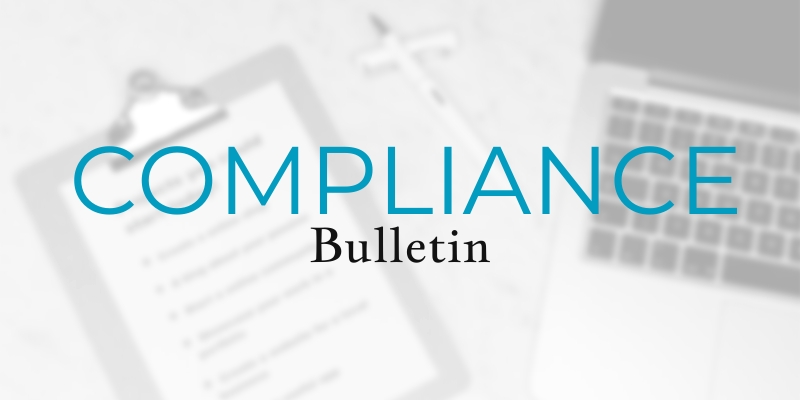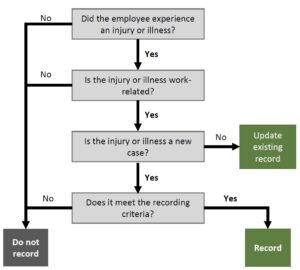 The Occupational Safety and Health Act (the Act) requires employers to report and record work-related injuries and illnesses. The Occupational Safety and Health Administration (OSHA) has indicated that COVID-19 infections are recordable injuries if they are work-related and they meet the Act’s recording criteria.
The Occupational Safety and Health Act (the Act) requires employers to report and record work-related injuries and illnesses. The Occupational Safety and Health Administration (OSHA) has indicated that COVID-19 infections are recordable injuries if they are work-related and they meet the Act’s recording criteria.
Recording requirements apply only to employers with more than 10 employees who are not in an exempt, low-risk industry.
In addition, employers must report incidents that result in an employee’s fatality within eight hours. Incidents that result in inpatient hospitalization, amputation or loss of an eye must be reported within 24 hours.
This Compliance Overview presents a summary of the reporting and recording requirements that will most likely apply to coronavirus cases in the United States. For additional information on OSHA reporting and recording requirements please contact Risk Management Advisors LLC or visit the OSHA
Links and Resources
Work-relatedness
An injury or illness is work-related if an event or exposure in the work environment either caused or contributed to the resulting condition or significantly aggravated a preexisting injury or illness.
Work-relatedness is presumed for events or exposures in the work environment.
Recording Criteria
Work-related COVID-19 cases are recordable if they:
- Result in loss of consciousness, days away from work, restricted work or transfer to another job;
- Require medical treatment beyond first aid;
- Are a diagnosed case of cancer, chronic irreversible disease, fractured or cracked bones or teeth, and punctured eardrums; or
- Meet the special recording criteria for work-related cases involving needlesticks and sharps injuries, medical removal, hearing loss or tuberculosis.
Recording COVID-19 Cases
 OSHA has clarified that COVID-19 can be a recordable illness if a worker is infected as a result of performing their work-related duties. Employers can use the graphic on the right to determine whether incidents should be recorded under the Act.
OSHA has clarified that COVID-19 can be a recordable illness if a worker is infected as a result of performing their work-related duties. Employers can use the graphic on the right to determine whether incidents should be recorded under the Act.
However, employers are only responsible for recording cases of COVID-19 if all of the following are met:
- The case is a confirmed case of COVID-19 (see CDC information on persons under investigation and presumptive positive and laboratory-confirmed cases of COVID- 19);
- The case is work-related, as defined by 29 CFR 1904.5; and
- The case involves one or more of the general recording criteria set forth in 29 CFR 1904.7 (e.g., medical treatment beyond first aid, or days away from work).
OSHA’s definition of a recordable illness includes “both acute and chronic illnesses, such as, but not limited to, a skin disease, respiratory disorder or poisoning.” This definition is limited to abnormal conditions or disorders that exclude the common cold and the seasonal flu. This can make it difficult when employees show up to work with coronavirus-like symptoms, such as a high fever or coughing. For this reason, employers should wait until they have a confirmed COVID-19 diagnosis before starting a recordability analysis.
Reporting COVID-19 Cases
As mentioned above, COVID-19 cases must be reported if they are work-related and result in a fatality (within eight hours), inpatient hospitalization, amputation or loss of an eye (within 24 hours). The reporting periods begin as soon as the employer learns about the work-related incident, even if there is a delay between the time the incident takes place and the time the incident is reported to the employer.
If the OSHA area office is closed, employers are expected to report these incidents by phone at 1-800-321-OSHA (6742) or the reporting application located on OSHA’s public website at www.osha.gov. OSHA reports must include the following information:
- The establishment name;
- The location of the work-related incident;
- The time of the work-related incident;
- The type of reportable event (i.e., fatality, inpatient hospitalization, amputation or loss of an eye);
- The number of employees who suffered a fatality, inpatient hospitalization, amputation or loss of an eye;
- The names of the employees who suffered a fatality, inpatient hospitalization, amputation or loss of an eye;
- The employer’s contact person and his or her phone number; and
- A brief description of the work-related incident.
Inpatient Hospitalizations
An inpatient hospitalization is a formal admission to the inpatient service of a hospital or clinic for care or treatment. Admissions that are strictly for observation or diagnostic testing are not reportable.
Delayed Reporting
Employers must report fatalities to OSHA if they occur within 30 days of the work-related incident.
Inpatient hospitalizations, amputations and loss of an eye must be reported even if they take place within 24 hours of the work-related incident.


